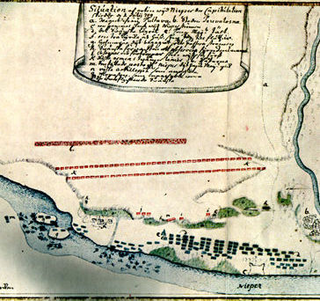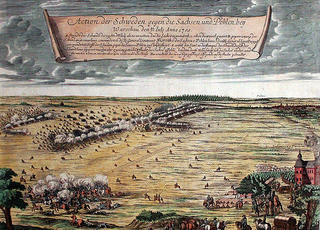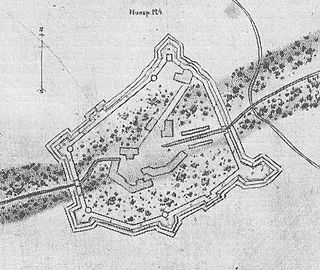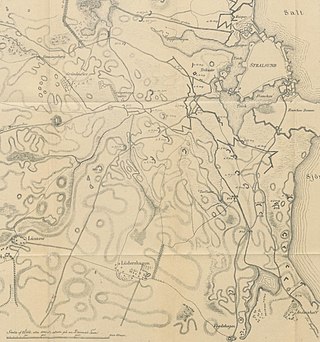
The Battle of Lesnaya was one of the major battles of the Great Northern War. It took place on October 9 [O.S. September 28] 1708 between a Russian army of between 26,500 and 29,000 men commanded by Peter I of Russia, Mikhail Mikhailovich Golitsyn, Aleksandr Danilovich Menshikov, Christian Felix Bauer and Nikolai Grigorovitj von Werden and a Swedish army of about 12,500 men commanded by Adam Ludwig Lewenhaupt and Berndt Otto Stackelberg, at the village of Lesnaya, located close to the border between the Polish–Lithuanian Commonwealth and Russia. The Swedes were escorting a supply column of more than 4,500 wagons for their main army in Ukraine.

The Battle of Leipzig, also known as the Battle of the Nations, was fought from 16 to 19 October 1813 at Leipzig, Saxony. The Coalition armies of Austria, Prussia, Sweden, and Russia, led by Tsar Alexander I and Karl von Schwarzenberg, decisively defeated the Grande Armée of French Emperor Napoleon Bonaparte. Napoleon's army also contained Polish and Italian troops, as well as Germans from the Confederation of the Rhine. The battle was the culmination of the German Campaign of 1813 and involved 560,000 soldiers, 2,200 artillery pieces, the expenditure of 400,000 rounds of artillery ammunition, and 133,000 casualties, making it the largest battle of the Napoleonic Wars, and the largest battle in Europe prior to World War I.

The Battle of Poltava was the decisive and largest battle of the Great Northern War. A Russian army under the command of Tsar Peter I defeated a Swedish army, under the command of Carl Gustaf Rehnskiöld. The battle put an end to the status of the Swedish Empire as a European great power, as well as its eastbound expansion, and marked the beginning of Russian influence in Northern Europe.

The Battle of Fraustadt was fought on 2 February 1706 (O.S.) / 3 February 1706 / 13 February 1706 (N.S.) between Sweden and Saxony-Poland and their Russian allies near Fraustadt in Poland. During the Battle of Fraustadt on February 3, August II was only 120 km away, with a cavalry force about 8,000 men strong. According to Cathal Nolan that caused Swedish General Rehnskiöld to rush to engage Schulenburg. The Swedes were outnumbered by more than two to one by Saxons, mercenaries, and Russians. Ignoring the odds, Rehnsköld attacked the enemy's well-entrenched position. He sent cavalry to drive off defending Saxon horse on either wing and complete a classic double envelopment. The manoeuvre meant they could attack from behind into the center rear of the enemy's main line. The result was 8,000 Russian deaths and 5,000 Saxons and German mercenaries taken prisoner. The battle is a textbook example of a perfect pincer movement and was one of Sweden's key victories in the Great Northern War.
The Polish–Swedish wars were a series of wars between the Polish–Lithuanian Commonwealth and Sweden. Broadly construed, the term refers to a series of wars between 1563 and 1721. More narrowly, it refers to particular wars between 1600 and 1629. These are the wars included under the broader use of the term:

The Battle of Lund, part of the Scanian War, was fought on December 4, 1676, in an area north of the city of Lund in Scania in southern Sweden, between the invading Danish army and the army of Charles XI of Sweden. The Danish had an army of about 13,000 under the personal command of 31-year-old King Christian V of Denmark, aided by General Carl von Arensdorff. The Swedish army, which numbered about 8,000, was commanded by Field Marshal Simon Grundel-Helmfelt and the 21-year-old Swedish king Charles XI. It is one of the bloodiest battles in percent of casualties on both sides ever fought in Scandinavia.

Count Carl Gustav Rehnskiöld was a Swedish Field Marshal (fältmarskalk) and Royal Councillor. He was mentor and chief military advisor to King Charles XII of Sweden, and served as deputy commander-in-chief of the Carolean Army, an army he assisted both in its education and development.

The Crossing of the Düna took place during the Great Northern War on July 19, 1701 near the city of Riga, present-day Latvia. The Swedish king Charles XII was in hot pursuit of king Augustus II the Strong of the Polish–Lithuanian Commonwealth and Saxony. The crossing was easily made, and the coalition troops were quickly broken and retreated.

The invasion of Russia by Charles XII of Sweden was a campaign undertaken during the Great Northern War between Sweden and the allied states of Russia, Poland, and Denmark. The invasion began with Charles's crossing of the Vistula on 1 January 1708, and effectively ended with the Swedish defeat in the Battle of Poltava on 8 July 1709, though Charles continued to pose a military threat to Russia for several years while under the protection of the Ottoman Turks.

The Battle of Molyatichi, also known as the Battle of Dobroye, took place on August 31, 1708 at Molyatichi during the Great Northern War. The Russian army of Peter the Great under the command of Mikhail Golitsyn successfully attacked the avantgarde of the Swedish Army of Charles XII under Carl Gustaf Roos. The fighting occurred in the swamp between the rivers Belaya Natopa and Chernaya Natopa. The Swedish force under Roos was surprised by the Russian attack in the morning fog and steadily withdrew towards the main Swedish army. The swampy landscape prevented the Russian cavalry to cut off the Swedish way of retreat. As Swedish reinforcements arrived, the Russians were put on the defensive. Since the attack of the main body of the Swedish army was not part of the Russian intentions at that moment, and to avoid a disastrous defeat, the Russians withdrew. According to the Russian description, this was done in order, while the Swedish one claims their retreat turned into a disorganized flight as the Swedes pursued. Many Russians were killed in the swamps.

The Battle of Poniec took place on October 28, 1704 in Poniec, Poland, during the Great Northern War. The Swedish Army under Charles XII unsuccessfully dislodged the Saxon Army under Johann Matthias von der Schulenburg through several cavalry charges. The Saxons had deployed in a massive square formation near the village of Janiszewo, west of Poniec.

The surrender at Perevolochna was the capitulation of almost the entire Swedish army on 30 June 1709 (O.S.) / 1 July 1709 / 11 July 1709 (N.S.). It signified the virtual annihilation of the once formidable Swedish army after the defeat at Battle of Poltava, and paved the way for the eventual Russian victory in the Great Northern War. After the Battle of Poltava, Charles XII escaped to Moldavia, a vassal state of the Ottoman Empire.

The Battle of Warsaw was fought on 31 July 1705 near Warsaw, Polish–Lithuanian Commonwealth, during the Great Northern War and Swedish invasion of Poland (1701–1706). The battle was part of a power struggle for the Polish–Lithuanian throne. It was fought between Augustus II the Strong and Stanisław Leszczyński and their allies. Augustus II entered the Northern war as elector of Saxony and king of the Polish–Lithuanian Commonwealth, and had formed an alliance with Denmark–Norway and Russia. Stanisław Leszczyński had seized the Polish throne in 1704, with the support of the Swedish army of Charles XII of Sweden. The struggle for the throne forced the Polish nobility to pick sides; the Warsaw Confederation supported Leszczyński and Sweden, and the Sandomierz Confederation supported Augustus II and his allies. The conflict resulted in the Polish civil war of 1704–1706.

The Battle of Krasnokutsk–Gorodnoye took place on February 20–22, 1709, in the Swedish campaign of Russia during the Great Northern War. The Swedish troops were directly led by Charles XII King of Sweden who pursued a force of Russians commanded by Otto Rudolf von der Schaumburg from the minor battle of Krasnokutsk to the town Gorodnoye where a new battle took place, with the Russians now commanded by Karl Evald von Rönne. The Swedes were victorious but cancelled their offensive when the night fell.
The Battle of the Neva took place on September 9, 1708 during the Swedish invasion of Russia in the Great Northern War. While Charles XII had started his offensive against Russia from his winter quarters in Saxony, the Swedish–Finnish army of 12,000 men under the command of Georg Lybecker went in field to interrupt and possibly capture the newly-established ports and town of Saint Peterburg, which had been built on Swedish land. This was intended to draw the attention and troops from the main Russian army facing Charles. The Russian forces stationed in Ingria consisted of 24,500 men of which the command had been appointed to Fyodor Apraksin. While having reached the river of Neva the Swedes under Lybecker prepared their crossing. Apraksin had fortified the opposite bank with about 8,000 men and several boats patrolling the river.

The Battle of Petschora took place on February 23, 1701 near the village of Pechory, Russia during the second year of the Great Northern War. The Swedish army of about 2,100 men assisted by approximately 2,000 peasants under the command of Jacob Spens defeated a Russian force of about 6,000 men.

The Campaign of Grodno was a plan developed by Johann Patkul and Otto Arnold von Paykull during the Swedish invasion of the Polish–Lithuanian Commonwealth, a part of the Great Northern War. Its purpose was to crush Charles XII's army with overwhelming force in a combined offensive of Russian and Saxon troops. The campaign, executed by Peter I of Russia and Augustus II of Saxony, began in July 1705 and lasted almost a year. In divided areas the allies would jointly strike the Swedish troops occupied in Poland, in order to neutralize the influence the Swedes had in the Polish politics. However, the Swedish forces under Charles XII successfully outmaneuvered the allies, installed a Polish king in favor of their own and finally won two decisive victories at Grodno and Fraustadt in 1706. This resulted in the Treaty of Altranstädt (1706) in which Augustus renounced his claims to the Polish throne, broke off his alliance with Russia, and established peace between Sweden and Saxony.
The Battle of Wismar took place on December 5, 1711 close to Wismar, Swedish Empire during the Great Northern War. A 3,000 strong Danish force under the command of Jørgen Rantzau blocked the Swedish city of Wismar. The Swedes under Martin von Schoultz, sent out 2,500 men from their garrison in an attempt to surprise the Danish forces camping a distance away. However, the Danish commander got words of the approaching Swedes and countered them, resulting in 478 Swedes dead, with another 1,500 captured to only 300 Danes killed and wounded.

The Great Sortie of Stralsund was fought in the Franco-Swedish War on 1–3 April 1807, in Swedish Pomerania. A French army under Édouard Mortier invaded Swedish Pomerania in early 1807 and initiated a blockade of the Swedish town of Stralsund, to secure the French rear from enemy attacks. After several smaller sorties and skirmishes around Stralsund, Mortier marched part of his army to support the ongoing Siege of Kolberg, leaving only a smaller force under Charles Louis Dieudonné Grandjean to keep the Swedes at check. The Swedish commander Hans Henric von Essen then commenced a great sortie to push the remaining French forces out of Swedish Pomerania. The French fought bravely on 1 April at Lüssow, Lüdershagen and Voigdehagen, but were eventually forced to withdraw; the Swedes captured Greifswald the next day, after a brief confrontation. The last day of fighting occurred at Demmin and Anklam, where the Swedes took many French prisoners of war, resulting in the complete French withdrawal out of Swedish Pomerania—while the Swedes continued their offensive into Prussia. After two weeks Mortier returned and pushed the Swedish forces back into Swedish Pomerania. After an armistice the French forces once again invaded, on 13 July, and laid siege to Stralsund, which they captured on 20 August; all of Swedish Pomerania was captured by 7 September, but the war between Sweden and France continued until January 6, 1810, when the Swedes were finally forced to sign the Treaty of Paris.

The Drabant Corps of Charles XII was the most prestigious unit in the Swedish Army during the time of the Great Northern War. As a result of the reforms of 1700, all personnel in the corps received an officer's rank with increased wages, while its size was eventually set at 168 men. Those serving as Drabants were almost exclusively recruited from the Swedish Empire, with most coming from Sweden. The corps was issued the finest weapons, horses, and clothing was often adorned with gold lacing. They fought according to the cavalry regulations of the Caroleans, emphasizing the cold-steel charge in slight wedge formations, knee behind knee, over the more common caracole. This strategy allowed them to function as a bodyguard for the king as well as an elite combat unit, often playing a crucial role in the battles despite their relatively small size. During the war, the corps frequently marched with the main army and the king, fighting in most battles.















